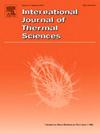The coupling effects of oxide particle microstructural parameters and atmospheric (temperature, pressure, composition) conditions on thermal transport in powder beds
IF 4.9
2区 工程技术
Q1 ENGINEERING, MECHANICAL
International Journal of Thermal Sciences
Pub Date : 2025-05-08
DOI:10.1016/j.ijthermalsci.2025.109945
引用次数: 0
Abstract
This study investigates the interdependent influence of microstructural parameters and thermodynamic (temperature between 298 K and 473 K, pressure between 0.1 Pa and 3 107 Pa, various gas composition e.g., air, Ar, H, He, N) conditions of the atmosphere on thermal transport within granular media. To accurately describe the thermal conductivity behavior, we propose an extended analytical model based on the Rombouts’s model (Rombouts et al., 2005). This study investigates three types of microstructures: dense non-cohesive particles, dense and cohesive particles and porous non-cohesive particles. Analysis of the results provides a precise understanding of the influence of these typical microstructure parameters on thermal conductivity. We underscore the pivotal roles of intraparticle porosity in governing the heat transfer transition in the gas phase. A comparative analysis between our model and a percolation model approach reveals a robust correlation between the two formulations. Our findings indicate that an increase in conductance between particles leads to an enhanced thermal coordination within the system, consequently shifting the thermal percolation threshold to higher values (from 0.1 to 0.5).
氧化颗粒微观结构参数与大气(温度、压力、成分)条件对粉末床热输运的耦合影响
本研究考察了微观结构参数和大气热力学条件(温度在298 K至473 K之间,压力在0.1 Pa至3 107 Pa之间,空气、Ar、H2、He、N2等不同气体组成)对颗粒介质内热输运的相互影响。为了准确地描述导热行为,我们提出了一个基于Rombouts模型的扩展分析模型(Rombouts等人,2005)。本研究研究了三种类型的微观结构:致密非粘性颗粒、致密有粘性颗粒和多孔非粘性颗粒。对结果的分析提供了对这些典型微观结构参数对导热系数的影响的精确理解。我们强调了颗粒内孔隙度在控制气相传热转变中的关键作用。我们的模型和渗流模型方法之间的比较分析揭示了两种公式之间的强大相关性。我们的研究结果表明,颗粒之间电导的增加导致系统内热协调的增强,从而将热渗透阈值转移到更高的值(从0.1到0.5)。
本文章由计算机程序翻译,如有差异,请以英文原文为准。
求助全文
约1分钟内获得全文
求助全文
来源期刊

International Journal of Thermal Sciences
工程技术-工程:机械
CiteScore
8.10
自引率
11.10%
发文量
531
审稿时长
55 days
期刊介绍:
The International Journal of Thermal Sciences is a journal devoted to the publication of fundamental studies on the physics of transfer processes in general, with an emphasis on thermal aspects and also applied research on various processes, energy systems and the environment. Articles are published in English and French, and are subject to peer review.
The fundamental subjects considered within the scope of the journal are:
* Heat and relevant mass transfer at all scales (nano, micro and macro) and in all types of material (heterogeneous, composites, biological,...) and fluid flow
* Forced, natural or mixed convection in reactive or non-reactive media
* Single or multi–phase fluid flow with or without phase change
* Near–and far–field radiative heat transfer
* Combined modes of heat transfer in complex systems (for example, plasmas, biological, geological,...)
* Multiscale modelling
The applied research topics include:
* Heat exchangers, heat pipes, cooling processes
* Transport phenomena taking place in industrial processes (chemical, food and agricultural, metallurgical, space and aeronautical, automobile industries)
* Nano–and micro–technology for energy, space, biosystems and devices
* Heat transport analysis in advanced systems
* Impact of energy–related processes on environment, and emerging energy systems
The study of thermophysical properties of materials and fluids, thermal measurement techniques, inverse methods, and the developments of experimental methods are within the scope of the International Journal of Thermal Sciences which also covers the modelling, and numerical methods applied to thermal transfer.
 求助内容:
求助内容: 应助结果提醒方式:
应助结果提醒方式:


